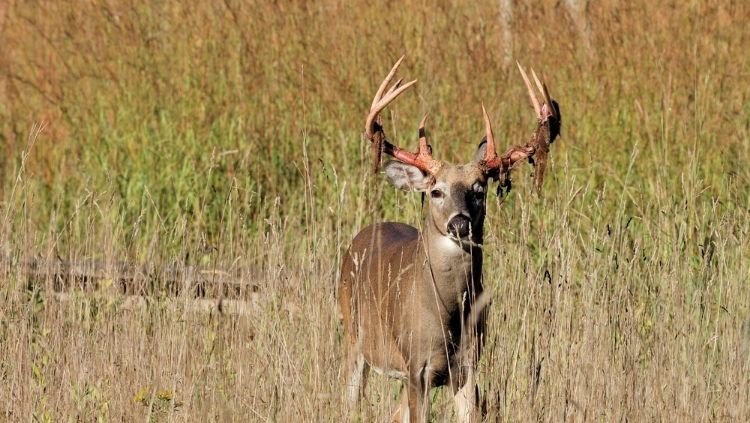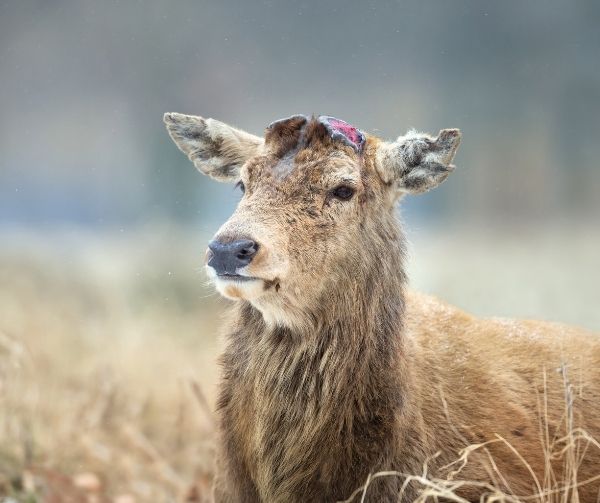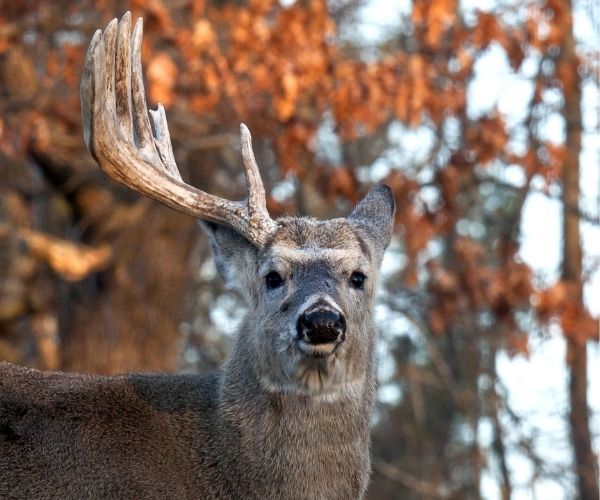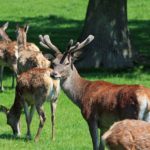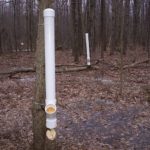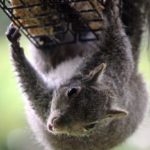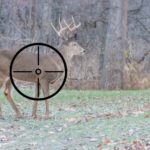Antlers provide the trophy many hunters seek, whether they’re going after a monster buck or walking the woods looking for shed antlers.
And those bucks stand proud of their antlers, too. It’s a symbol of their health, an indicator of their masculinity, and a warning to other bucks of their dominance. Those antlers grow bigger every year. The process involves shedding the old antlers and regrowing a new rack, better than last season.
However, antlers are bone!
Anybody who’s broken a bone knows even a tiny fracture can be immensely painful. And a deer’s antlers are grown from the skull and are directly connected until they fall off.
Does this mean that deer experience pain every year when their antlers fall off?
The short answer is no.
Deer can experience discomfort when they lose their antlers, but it isn’t painful. Once the velvet is gone, the antler is no longer connected to the nervous system. After mating season, osteoporosis occurs at the base of bucks’ antlers, which weakens then separates them from the skull without trauma.
I know I like learning all I can about the animals I hunt. It gives me more respect for the game I take and makes me a better hunter. I consider it part of being a responsible hunter.
Want to learn more about deer biology? Read on to sate your curiosity!
Why Deer Don’t Hurt When They Shed Antlers
The short answer for why deer antlers don’t hurt is because they are designed to fall off and regrow every year.
That’s not a satisfying answer, so let’s go into more detail.
Deer antlers are mostly protein and ash, cartilage. They start life as velvet, which is soft and has lots of blood flow to bring in nutrients.
Later, ossification adds minerals, mainly calcium. This makes the antlers tough enough for combat and turns them into true bone.
Once the antler is fully grown, a bony circular protrusion called the burr blocks off the nerves and blood vessels. This causes the velvet to wither and fall off of the calcified antlers.
Each antler is basically dead bone by that point.
Remember, antlers are weapons. If they were full of sensitive nerves, then bucks wouldn’t be able to clash with antlers locked together!
After the breeding season is finished, those minerals start to break down, especially at the pedicle, where the antler connects to the skull.
Osteoclasts are the cells responsible for this.
As this demineralization process continues, the connection between skull and antler weakens until it eventually falls off.
Think of it as a scab. If you leave it alone, like your mother told you to, it’ll eventually fall off on its own.
However, if you tear off that scab too early, you can catch the surrounding flesh. Ouch!
Do Deer Feel Pain If Their Antler Breaks?
But what if the antler gets broken after the velvet is gone but before it falls out naturally? Does the deer feel pain then?
This depends on which part breaks.
If the antler itself is chipped or fractured or tines break off, then the deer won’t feel pain from the antler directly.
The shock of whatever impact caused the antler to break can jerk the deer’s neck around and cause pain there, though.
But if the entire antler is torn out before the shedding process is complete, the deer will likely suffer some pain as the antler’s base is still partially fused to the pedicle.
Do Deer Bleed When They Shed Their Antlers?
Deer can bleed a little when their antlers fall out.
The ring of bone at the antler’s base blocked blood flow before but cannot once the antler is gone.
This invariably opens up a few of the blood vessels, causing a minor amount of bleeding.
Minor bleeding like this is typically not a problem.
However, any break in the skin’s barrier can allow harmful bacteria to enter and cause disease.
In this case, Trueperella pyogenes bacteria can enter into the pedicle and make their way to the brain.
This infection can lead to a brain abscess, which can lead to cranial abscessation syndrome (CAS) and cause weird or aggressive behavior.
CAS can not spread from deer to deer. However, it can lead to bacteria-filled pus in the deer’s head.
So, if you find signs of such an infection, you should not consume any part of the deer’s head.
Thankfully, scab forms rather quickly thanks to the small yet numerous blood vessels in the area, so deer are not left with an open wound for long.
Do Deer Feel Pain in Their Antlers?
Though deer do not feel pain in their antlers when they are fully calcified, they can feel pain before that process is complete.
Deer velvet needs more than just blood to grow the antlers. It needs nerves, too.
If you observe deer in spring, then you’ll notice the bucks are trying to avoid bumping their antlers into anything.
That’s because of the nerves in the vulnerable velvet. Those nerves can even help with proprioception, which is the feeling you have that tells you where your limbs are even when you’ve closed your eyes.
All those nerves are sensitive. Banging velvet-covered antlers into trees can hurt!
But a stubbed antler is not the only problem this can cause.
Any damage to velvet can disrupt the antler’s growth pattern.
This disruption can lead to malformed antlers, which are ineffective at blocking or locking the other buck’s antlers in a fight. This harms the buck’s chances at mating and can increase the chances of injury.
And, since the antler is cartilage and not bone at this point, a severe enough shock can break off points from the antler. This can ruin the rack’s score.
What’s worse is that this damage can reappear in the fresh antlers next year!
So, deer have more reason to avoid bumping their antlers than just a bit of pain.
Does it Hurt When a Deer Sheds its Velvet?
Does this mean that deer scrape off their velvet because it’s itching? Or painful?
No.
Velvet is dead, with its blood flow and nerves cut off before it’s shed from the antlers.
Careful observation of adult male deer before the mating season and after their antlers are fully grown can reveal that bucks are perfectly fine with dead velvet hanging from their antlers most of the time.
Then their testosterone surges for the upcoming male dominance displays, and they scrape all velvet remnants off of their antlers.
What Happens When Deer Shed Antlers?
When a deer sheds their antlers, the antler’s base separates from the pedicle, the permanent nubs on top of the deer’s skull.
This can disrupt some blood vessels and leave a circular open wound on top of the deer’s head. It’s pink, not a full-on bloody red.
If you pick up a freshly-dropped antler, you will find a small remnant of fresh blood on the bottom of it. That’ll quickly dry and decompose, so most people won’t see that pinkness.
As for the animal, the first thing a deer feels when its antlers are shed is probably relief! They no longer have those weights above their head, catching on trees and brush.
However, the cycle continues.
Fresh antlers start growing almost immediately.
As for the antlers themselves, they become part of the ecosystem’s cycle.
Each antler is the perfect post-workout snack if your teeth are up to the task. An antler contains a large amount of protein as well as a large percentage of minerals and vitamins.
Calcium alone makes up 20% of an antler!
These nutrients are desired by the myriad woodland creatures who can chew into dried bone.
Rodents such as mice and squirrels are the furry beasts that try to snack on antlers before you can pick them up. Larger animals, from dogs to bears, can also supplement their diet with deer antlers.
You better get to the antlers quickly before they become some critter’s dinner!
Why Do Deer Shed Antlers?
This question can be answered in one of two ways.
Physiologically, we know why deer shed their antlers.
The post-rut period causes testosterone levels to drop. This triggers the localized osteoporosis process that weakens the connection between pedicle and antler.
As for why this process occurs in the first place…
Antlers are the fastest-growing bone structures we know about.
Deer don’t hunt down other animals to chow on them for the required protein and calcium. Even the healthiest buck doesn’t have enough nutritional stores to cover the antler growing process all at once.
So, their body has to use nutrients from elsewhere in the body to make up the difference.
This leads to weakened skeletons until the antlers have finished ossification and the deer can intake enough nutrients to bulk up before the rut.
Antlers are a harsh handicap on the animal’s survivability.
So, why are they regrown every year? Horned animals only have to grow their horns once.
As it turns out, antler size is an excellent predictor of male deer fertility.
A larger rack of antlers means that the buck is better at, ah, guaranteeing pregnancy.
As a buck grows older, he becomes healthier and more fertile. Growing fresh antlers every year shows this off to the curious doe.
And antlers cannot grow a little bit longer every year, unlike a horn.
That’s because the velvet has to fall off else; the buck’s biggest weapon is also his most significant weak point.
And growing from the base is out of the picture since too much growth there would cause the antlers to curve together, becoming entangled and useless!
Also, each year’s set of antlers causes its metabolic demand. This makes antlers an up-to-date indicator of fertility.
The buck cannot have a growth spurt one year, then get sick the next year and have almost no growth, but still, look like a large-racked monster buck.
The above points are all derived from available evidence and, though they are likely to be why a deer’s antlers are shed every year, it’s not like we can sit down with the deer’s designer and ask them why deer shed antlers.
Do Moose or Elk Feel Pain When They Shed Their Antlers?
All of the above information applies to other antlered animals as well, whether they’re elk, moose, or caribou. All are cervids in the deer family.
Elk and moose may have antlers of a different shape than your mule deer, but the growth and shedding process is the same.
Reindeer are the only exception, though that’s only on a technicality. Female reindeer can grow antlers, too!
Fun fact:
Male reindeer shed their antlers around November, while female reindeer keep theirs until they birth their calves in spring.
This means that Rudolph the Red-Nosed Reindeer, who has antlers in December, is a gal.
Be sure to annoy your hunting partner with this fact while sitting in your comfortable tree stand!
Conclusion
Deer biology is fascinating. No other animal has the metabolic demand of growing a fresh set of bones to throw them away every year.
This may seem like a massive disadvantage, but it does help the female deer identify which male is the healthiest, most fertile, and, therefore, the best mate.
And, while losing bones attached to your skull may seem like a painful process, deer aren’t hurt by shedding their antlers.
Does it bleed? Yes. Does it hurt? No.
Antler growth and shedding come with risks, and velvet can be sensitive, but a smart buck who doesn’t smack his growing rack into trees won’t feel any pain from his antlers.
Just be sure to get out there and collect the antlers you want before the various forest critters eat them up!
Resources
- Hall, Bones and Cartilage: Developmental and Evolutionary Skeletal Biology, 104 [https://books.google.com/books?id=y-RWPGDONlIC&pg=PA103#v=onepage&q&f=false]
- https://extension.missouri.edu/publications/g9486
- https://dnr.wisconsin.gov/topic/WildlifeHabitat/disease.html
- https://www.rmef.org/elk-network/eats-elk-antlers/
- https://www.publish.csiro.au/an/AN15051
- https://www.ncbi.nlm.nih.gov/pmc/articles/PMC1634960/
- https://www.fda.gov/animal-veterinary/animal-health-literacy/fun-facts-about-reindeer-and-caribou

